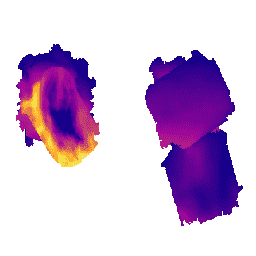
- Доступность набора данных
- 2021-07-30T00:00:00Z–2023-10-13T00:00:00Z
- Поставщик наборов данных
- Фонд защиты окружающей среды — MethaneSAT
- Теги
Описание
Модель выбросов на данной территории все еще находится в стадии разработки и не является репрезентативной для конечного продукта.
Этот набор данных содержит пространственно дезагрегированные данные о потоках выбросов метана (кг/ч), полученные на основе измерений, полученных с помощью MethaneAIR в районах добычи нефти и газа по всей территории США. Общий объём выбросов в исследуемой области рассчитывается путём суммирования значений пикселей.
Метан — мощный парниковый газ, чья способность к согреванию в течение первых 20 лет после попадания в атмосферу более чем в 80 раз превышает способность углекислого газа. Как минимум 30% сегодняшнего глобального потепления обусловлено метаном, образующимся в результате деятельности человека. Сокращение выбросов метана, связанных с деятельностью человека, включая предотвратимые выбросы от добычи нефти и газа, сельского хозяйства и утилизации отходов, — это самый быстрый способ замедлить темпы глобального потепления.
Выбросы на площади оцениваются на основе наблюдаемых значений XCH4 с использованием геостатистической модели обратной модели (см. набор данных «MethaneAIR L4 Area Sources» ). Модель атмосферного переноса — стохастическая лагранжева модель переноса с обратным временем «STILT»; Лин и др. (2003) , Фасоли и др. (2018) ; основанная на метеорологических данных из модели быстрого обновления высокого разрешения NOAA «HRRR», — используется для связи изменений наблюдаемых значений XCH4 с потенциальными источниками против ветра. Иерархический подход используется для разделения изменений XCH4, вызванных выбросами на площади, от изменений, вызванных выбросами из точечных источников или притоком через границу домена («фоновая» концентрация). Выбросы из точечных источников определяются индивидуально (см. набор данных «MethaneAIR L4 Point Sources» ) и предварительно вычитаются из наблюдаемого XCH4. Затем обратная модель используется для оценки притока XCH4 через границу домена. Наконец, площадные выбросы оцениваются с помощью геостатистической обратной модели с обязательным неотрицательным решением. Общие выбросы представляют собой сумму площадных и точечных выбросов.
Этот набор данных был создан на основе измерений MethaneAIR, проведенных во время полетов с 30 июля 2021 года по 13 октября 2023 года. MethaneAIR — это бортовой предшественник спутниковой миссии MethaneSAT, управляемый компанией MethaneSAT LLC , дочерней компанией Environmental Defense Fund. Потоки выбросов метана были получены с помощью геостатистической платформы обратного моделирования, специально разработанной для использования высокого пространственного разрешения, широкого пространственного охвата и высокой точности данных MethaneAIR. Не все продукты данных доступны для всех полетов.
Дополнительную информацию об инструменте MethaneAIR, калибровке прибора и обнаружении выбросов можно найти в недавних публикациях Лофнера и др. (2021) , Стэбелла и др. (2021) , Конвея и др. (2023) , Чулакадаббы и др. (2023) , Аббади и др. (2023) , Омары и др. (2023) и Миллера и др. (2023) .
Для получения дополнительной информации о проекте свяжитесь с поставщиком данных по этой ссылке: https://www.methanesat.org/contact/
Группы
Группы
| Имя | Единицы | Мин. | Макс | Размер пикселя | Описание |
|---|---|---|---|---|---|
flux | кг/ч/км^2 | 0* | 28.3* | 1000 метров | Выбросы метана зафиксированы на площади 1 км². |
Свойства изображения
Свойства изображения
| Имя | Тип | Описание |
|---|---|---|
| идентификатор_полета | НИТЬ | Номер исследовательского рейса. |
| бассейн | НИТЬ | Нефтегазовый бассейн (например, Пермский) или интересующая область (например, Нью-Йорк). |
| время_покрытия_начала | НИТЬ | Время начала сбора данных в формате ГГГГ-ММ-ДДTчч:мм:ссZ STRING (ISO 8601). |
| время_покрытия_конец | НИТЬ | Время окончания сбора данных в формате ГГГГ-ММ-ДДTчч:мм:ссZ STRING (ISO 8601). |
| processing_id | НИТЬ | (внутренний) Идентификатор процесса обработки, представляющий вычисления, приведшие к появлению этих признаков. Это не атрибут, описывающий сам рейс, а конвейер обработки. |
| площадь_источника_всего_кг_ч | ИНТ | Суммарное значение выбросов в данном районе для данного рейса в кг/ч. Отсутствующие значения обозначены знаком -1. |
Условия эксплуатации
Условия эксплуатации
Использование этих данных регулируется Условиями использования лицензии на контент MethaneSAT .
Цитаты
Chulakadabba, A., Sargent, M., Lauvaux, T., Benmergui, JS, Franklin, JE, Chan Miller, C., Wilzewski, JS, Roche, S., Conway, E., Souri, AH, Sun, K., Luo, B., Hawthrone, J., Samra, J., Daube, BC, Liu, X., Chance, K., Li, Y., Gautam, R., Omara, M., Rutherford, JS, Sherwin, ED, Brandt, A. и Wofsy, SC 2023. Количественная оценка точечных источников метана с использованием MethaneAIR: новый спектрометр для получения изображений на борту самолета, Atmos. Meas. Tech., 16, 5771-5785. doi:10.5194/amt-16-5771-2023 ,
Исследуйте с Earth Engine
Редактор кода (JavaScript)
var dataset = ee.ImageCollection("EDF/MethaneSAT/MethaneAIR/L4area"); var fluxVisParams = { min: 0, max: 18, palette: ['#070088','#a3069b','#cc4e64','#ffa826','#edfb59'], }; // Center on one of the available areas of interests. Map.setCenter(-102.5, 31.85, 8); Map.addLayer(dataset, fluxVisParams, 'Methane area sources flux');
